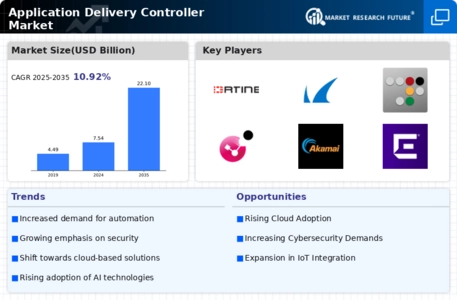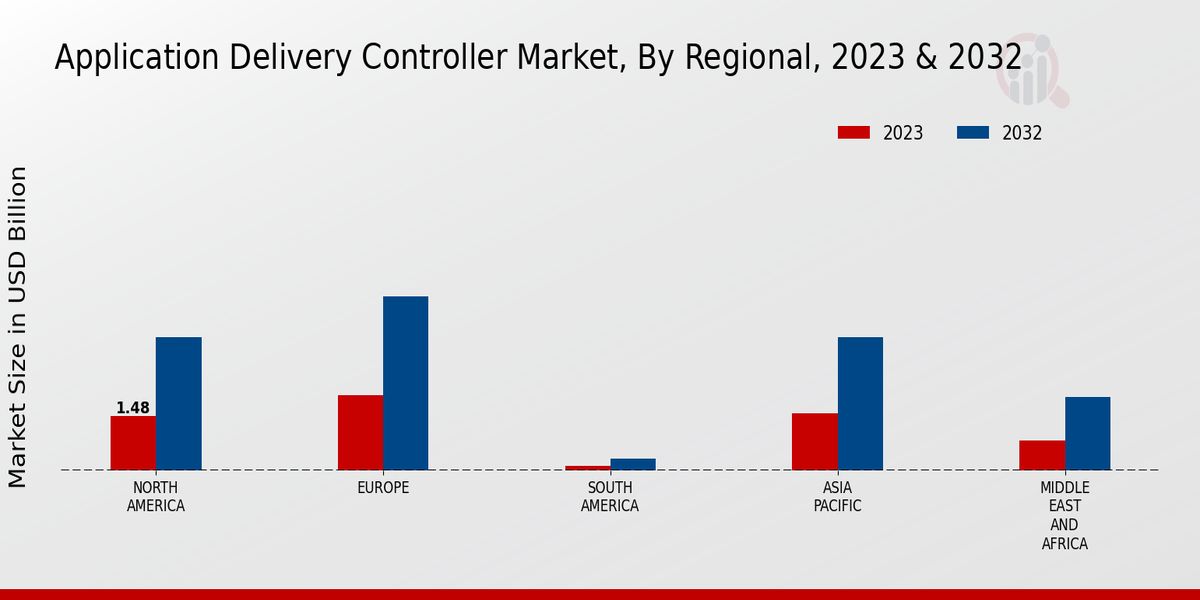Market Growth Projections
The Global Application Delivery Controller Market Industry is projected to experience substantial growth over the coming years. With a market valuation of 7.54 USD Billion in 2024, it is anticipated to reach 22.1 USD Billion by 2035. This growth trajectory suggests a compound annual growth rate of 10.26% from 2025 to 2035. Such projections indicate a robust demand for application delivery solutions, driven by factors such as increased cloud adoption, rising cybersecurity concerns, and the proliferation of mobile and IoT applications. This upward trend highlights the critical role of ADCs in supporting the evolving digital landscape.
Adoption of DevOps Practices
The Global Application Delivery Controller Market Industry is witnessing a shift towards DevOps practices, which emphasize collaboration between development and operations teams. This approach necessitates agile application delivery solutions that can adapt to rapid changes in software development cycles. ADCs support this transition by providing automation, scalability, and real-time monitoring capabilities. As organizations strive for faster deployment and improved application performance, the adoption of ADCs is likely to increase. This trend aligns with the broader movement towards agile methodologies, which are becoming essential for maintaining competitive advantage in the digital landscape.
Emergence of IoT Applications
The Global Application Delivery Controller Market Industry is also shaped by the emergence of Internet of Things (IoT) applications. As IoT devices proliferate, the demand for efficient application delivery solutions becomes paramount. ADCs are instrumental in managing the increased traffic generated by IoT applications, ensuring that data is transmitted securely and efficiently. This trend is particularly relevant in sectors such as healthcare and smart cities, where real-time data processing is critical. The integration of ADCs into IoT ecosystems is expected to enhance operational efficiency and drive market growth.
Rising Cybersecurity Concerns
In the context of the Global Application Delivery Controller Market Industry, the increasing prevalence of cyber threats compels organizations to prioritize cybersecurity measures. ADCs play a crucial role in safeguarding applications from potential attacks by providing features such as web application firewalls and DDoS protection. As businesses become more aware of the vulnerabilities associated with digital operations, the demand for ADCs is likely to surge. This heightened focus on security is anticipated to contribute to a compound annual growth rate of 10.26% from 2025 to 2035, underscoring the importance of robust application delivery solutions in mitigating risks.
Growing Mobile Application Usage
The Global Application Delivery Controller Market Industry is significantly influenced by the surge in mobile application usage. As more consumers rely on mobile devices for various services, businesses must ensure that their applications perform optimally across diverse platforms. ADCs facilitate this by optimizing application delivery, enhancing user experience, and ensuring high availability. This trend is particularly relevant in sectors such as e-commerce and banking, where user engagement is critical. The increasing reliance on mobile applications is expected to drive the market's growth, aligning with the overall expansion of the digital economy.
Increased Demand for Cloud Services
The Global Application Delivery Controller Market Industry experiences heightened demand for cloud services as organizations increasingly migrate their operations to cloud environments. This shift necessitates robust application delivery solutions to ensure optimal performance and security. As of 2024, the market is valued at 7.54 USD Billion, reflecting the growing reliance on cloud infrastructure. The integration of Application Delivery Controllers (ADCs) facilitates seamless application access, load balancing, and enhanced security measures. This trend is expected to continue, with projections indicating that by 2035, the market could reach 22.1 USD Billion, driven by the ongoing digital transformation across various sectors.



















